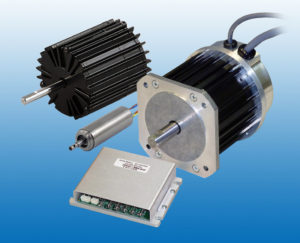Patented DPFlex Drive is Sensorless, Brushless Motor Control Done Right
Click here for more specifications
Choosing Between Brush and Brushless DC Motors — What are the Trade-Offs?

Brushless motors have become the first choice for many motor applications because of their increased efficiency and reduced operating costs. But one aspect of a brushless motor that is sometimes less appealing is the need for controlling motor commutation.
Traditionally, commutation is initiated with the help of Hall sensors. In other cases where an encoder is available, the encoder is used for commutation. These sensors increase motor cost, and they sometimes prohibit the use of a brushless motor because Hall sensors typically cannot handle the same extreme temperatures the rest of the motor can.
A sensorless, brushless motor would be ideal; however, with traditional sensorless motor control, there is a significant challenge getting the motor started. Allied Motion’s DPFlex Drive is a sensorless, brushless motor drive that starts brushless motors with ease.
Let’s compare the DPFlex drive with some alternative design options:
Automated Control
While there are a large number of “canned” sensorless chips available for automated control, these application-specific integrated circuits (ASICs) are only adequate for simple applications that do not have severe loads on startup or when torque-to-inertia ratios are large. With larger system inertias, ASIC-based sensorless drives often start roughly or simply fail to start.
The vast majority of the ASICs try to solve this startup problem by applying current to the stator, getting the rotor to line up with the stator field, and then slowly increasing frequency. Once the speed is past a given threshold level, the sensorless commutation routine can be engaged.
These single-chip solutions are not applicable to higher power applications either. For higher power applications, you generally need to design and build your own amplifier stage and install a processor to control everything. And, the addition of a processor necessitates developing firmware code for the product.
Determining Zero-Speed Position
In general, ASIC-based motor controls can be divided into two main “camps”. One method uses induced-voltage sensing technology, sometimes referred to as back EMF (back electromotive force, or BEMF) sensing to measure the induced voltage caused by the time-varying rotor magnetic field.
The other method is essentially observer-based. It predicts or observes the rotor position from phase current measurements (and perhaps others such as bus voltage) and estimates of circuit model values for the motor. Both schemes possess challenges at zero or low speed—the induced voltage signal is very small or zero, and low signal-to-noise ratio issues come into play.
Allied Motion’s DPFlex drive is superior to these other design approaches because it uses saturation to determine rotor position at zero-speed. Alternative saliency-based methods for position detection exist but give erroneous results in many cases.
The DPFlex system generates position estimates with greater resolution than just simple “Hall states,” setting it apart from other methods. By knowing the rotor’s position within a Hall state the DPFlex will start the motor reliably and robustly. The rotor will rotate in the desired direction and can accelerate to its full capability upon startup.
Measuring Rotor-Induced Voltage
Another shortcoming of many standard ASIC-based designs, especially those that use back EMF sensing, is that of rotor saliency induced BEMF voltage affects measured on the high impedance motor phase (the “off phase”). Because virtually all brushless motors exhibit saliency, this becomes yet another issue for ASIC-based drive designs. As a result, the measurements taken during the off state include a voltage contribution due to the di/dt (time rate of change of current) in the two active driving phases (the “on phases”). Other products that may seem comparable to the DPFlex measure signal samples at one point in a pulse-width modulation (PWM) switching cycle; taking them at only one point means the sign of the rate of change of the current would always be the same. This can produce false BEMF zero crossing information.
Allied Motion’s DPFlex Drive has improved upon this standard feature by conditioning the analog signal measured during the off phase and by taking samples of di/dt in both directions. This bipolar approach results in a much better and more reliable measurement of the rotor-induced voltage, enabling a smooth and robust automated startup.
By incorporating fine-tuned sensorless motor startup, Allied Motion’s patented DPFlex Drive provides the expected brushless motor benefits with the faultless startup that is desired. DPFlex is sensorless, brushless control done right.
